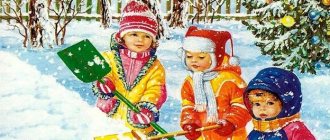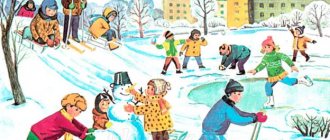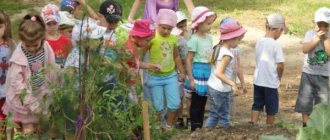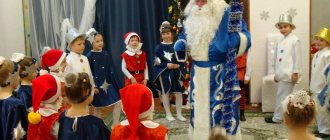Card file of walks in the preparatory group by season
The catalog of walks associated with the change of seasons is aimed at preschoolers of preparatory groups. Age-specific walks are divided into topics and involve exploring the characteristics of different seasons to form the child’s correct attitude.
Games in the winter air
Card file of winter walks in the preparatory group
Goal:
- form a set of ideas about winter changes in nature;
- teach to distinguish characteristic winter phenomena;
- direct children's interest to study natural phenomena.
Conducting observations:
- A clear winter day is suitable for a walk.
- While driving and at stops, you need to ask preschoolers to create a description of winter nature.
- Using a compass, determine which way the wind is blowing.
- What is the difference between January, February and December?
Conducting research work:
- Measuring snow depth in open areas and near trees. Children must explain why there is more snow in one place or another.
- Play the outdoor game “Stream”. Preschoolers must repeat characteristic body movements taking into account the progress of the game. Be sure to insist on compliance with the rules and order.
- Children take turns telling their favorite poem about winter. Then you should identify the characteristic signs of winter weather in the poem told.
Card index of spring walks in the preparatory group
Goal:
- form a set of ideas about spring changes in nature;
- teach to distinguish the characteristic signs of spring;
- expand previously acquired knowledge about inanimate nature through literary texts;
- direct children's interest to study the awakening of nature.
Conducting observations:
- The beginning of the walk is accompanied by a poetry competition about spring among preschoolers. Without naming the season, ask the children what time of year they are talking about based on the natural phenomena described in the poems.
- When walking in a group, be sure to focus on the obvious signs of spring that children can observe on their own.
- The observation process should affect the mechanism of formation of puddles and streams.
- What is the difference between May, March and April?
Picture of a spring walk
Conducting research work:
- Searching for the first flowers of spring. Children must describe their shape, color and features.
- Carrying out the game competition “Crow and Sparrows”. The group practices running in all directions with the development of spatial orientation.
- Intellectual exercise. Description of living nature with the obligatory guessing of a tree or flower.
Card file of autumn walks in the preparatory group
Goal:
- form a set of ideas about autumn changes in nature;
- teach to distinguish characteristic autumn changes in plants;
- expand previously acquired knowledge about inanimate nature;
- cultivate love for all living things.
Conducting observations:
- Before starting the walk, read a letter from autumn to the children inviting them to go for a walk.
- While walking, children name plants whose names they know.
- Compare the strength of the yellow and green leaves and ask the children to explain their conclusion.
- What are the main differences between October, November and September.
Signs of autumn
Conducting research work:
- Find out from children the signs of autumn changes in plants.
- Study the appearance of an autumn leaf. Why did he have dark spots?
- Explain to children the process of autumn withering and ask them to draw a conclusion about leaf fall and its causes.
- Play the game “Traps”. Preschoolers must learn to follow the rules and order when running in all directions.
- Learn to step over puddles with an explanation of the need for this.
Didactic games for visual arts in kindergarten
Card index of summer walks in the preparatory group
Goal:
- form a generalized idea of the summer season;
- teach to distinguish weather conditions in summer;
- expand previously acquired knowledge about plants, insects and birds;
- increase children's positive perception of the beauty of summer nature.
Conducting observations:
- While walking, pay attention to the length of the summer day, the characteristics of hot weather and precipitation temperatures.
- Children characterize the process of cloud movement by their shape and color.
- Obvious signs of summer are listed, indicating what was seen during the walk.
- The life of insects is observed with an explanation of the purposes of their activities.
Summer walk for preschoolers
Conducting research work:
- Using a thermometer, you need to determine the number of degrees in an open space, in a shaded area and in a pond. Be sure to draw conclusions.
- Carrying out the intellectual game “Water Cycle”. Children listen to the text while performing certain movements in sequence. The game develops attentiveness.
- Carrying out the game competition “Crow and Sparrows”. The group practices running in all directions with the development of spatial orientation
Objects and topics of observation during walks in the preparatory group
On a note! Walks in the preparatory group of the file cabinet with goals for the Federal State Educational Standard should be carried out on a specific topic. The choice of topic is determined by the possibility of observing certain objects.
The location of the walk, weather conditions and additional factors also matter.
Transport observations
It is better to divide vehicle observations into several parts depending on the type of vehicle or driver actions.
- General surveillance of transport. The goal is to familiarize children with different types of cars. Preschoolers should clearly distinguish between the concepts of trucks, buses and cars. It is necessary to determine the basic functions of all modes of transport. It is necessary to distinguish the elements and parts of the car according to their intended purpose.
- Freight transport. Preschoolers name the types of trucks they know and what activities are inherent in them. The emphasis is on the functional features of the car's appearance.
- Passenger transport. What is it intended for? What is the difference between buses, trolleybuses and trams? What type of transport does a particular family use?
- Cars. What is the fuel used for? Where are the cars located when the owner is absent? What can be transported by such transport.
- Driver's job. Familiarize the group with the characteristics of the driver’s work with a mandatory positive assessment of this work.
- Traffic light operation. Which color is responsible for the different actions of a pedestrian and driver.
Observations of seasonal phenomena
The teacher organizes observation for the purpose of long-term and active perception by preschoolers of changes in nature according to the seasons.
Each season has its own characteristics:
- Autumn. As it gets colder, the teacher suggests dressing the doll according to the air temperature. On the street, children determine the temperature of living and inanimate objects by touch in sunny weather and when it is cloudy. Be sure to focus on the appearance of yellow leaves and the frequency of rain.
- Winter period. You can use the doll again. At the same time, pre-specify the low temperature so that children can dress correctly. On the street, you can take off your mittens for a short time to feel the cold. Assess with the children the level of snow cover in various parts of the kindergarten with the obligatory conclusion about what they see.
Preparatory group weather calendar
- Spring. Pay attention to the appearance of puddles and streams. You can launch a boat on the water. Children must explain how and why nature wakes up, taking into account the brightness of the sun. Monitor the air temperature. An important point is to observe the first flowers and the swelling of the buds.
- Summer. What signs characterize the summer period? Pay attention to the difference in temperature, air, water and heated inanimate objects. Why trees sway and how insects behave.
Classes on drawing a mother's portrait in middle kindergarten groups
Observations of the sun
Goal:
- form an idea of the beauty of the sky;
- teach to distinguish the sun's rays;
- increase children's positive perception of summer.
Carrying out observations
Assess the position of the Sun:
- Where is it in the morning?
- What is the evening location?
- Which space was illuminated better in the morning and which in the evening.
- Draw a conclusion about the length of daylight hours.
Conducting research work:
- Standing with your back to the Sun, explain the concept of shadow.
- Where is the shadow of various visible objects.
- Is it possible to chase a shadow or dance with it?
Observations of inanimate nature
Goal:
- consolidate knowledge about the various states of water;
- form the concept of inanimate nature;
- describe the signs of ice and snow.
Conducting observations:
- Why does ice turn into water when heated?
- Preschoolers name the characteristic features of ice and snow.
- Explain the water cycle in nature.
- What are the differences between snow in warm and cold weather?
Conducting research work:
- Conduct an experiment on melting large and small ice.
- Pack the snow tightly into a glass and compare the rate of its melting with a loosely collected mass of the same volume.
- Carry out finger gymnastics “Ice”.
Long-term planning of outdoor observations in the preparatory group for a year
Elena Shcherbakova
Long-term planning of outdoor observations in the preparatory group for a year
Long-term planning of observations for September
Objects Contents Methodological techniques
Flora • Observe the beauty of autumn leaves on the trees, note the trees that begin to turn yellow first
•Note the condition of the flower garden: most of the plants have finished growing and are beginning to fade
• To consolidate the characteristic properties of vegetables and fruits, distinguish them by place of growth, know their benefits for humans
• Strengthen the characteristic properties of mushrooms, develop the ability to distinguish edible mushrooms from inedible ones
• Deepen understanding of grain plants (rye, wheat, oats, barley, corn)
• Examination of paintings, illustrations
• Conversation “The Beginning of Autumn”
• Didactic games to reinforce the names and appearance of plants
Fauna • Observe bumblebees , note that insect life is dying out
• Watch the birds gather in flocks and fly south • Look at the illustrations
• Teacher's story
• Reading A. Kushnir “Birds”
N. Sladkov “Autumn is on the threshold”
Inanimate Nature • Remind about keeping a calendar and the need to pay attention to weather conditions
• Note the reduction in daylight hours and the height of the sun using a conventional measure
• Introduce the thermometer • Experiments with a balloon
• Experience – lower a pebble into water
• Conversation “What is air”
The work of people in nature • Talk about harvesting in gardens and vegetable gardens, preparing for the winter
• Introduce autumn field work, explain the need to plow the field
• Talk about sowing winter crops
• systematize knowledge about people’s work in the fall, cultivate respect for agricultural work • examination of illustrations
• teacher's story
• reading L. Voronkov “Sunny Day”
Excursion, target walk Target walk to the vegetable tent.
Goal: continue to learn to distinguish and name vegetables and fruits; continue to form elementary ideas about autumn changes in nature.
Excursion to the roadway.
Purpose: surveillance of transport . Learn to recognize and name some types of transport. Develop powers of observation and memory.
Long-term planning of observations for October
Objects Contents Methodological techniques
Flora • Observe leaf fall in calm and windy weather, explain the reason for the fall of leaves
• Develop the ability to establish cause-and-effect relationships
• Examine ripe seeds and berries, collect them for winter feeding of birds
• Practice identifying and naming seeds and fruits
• Observe the plants in the area: there are almost no flowers, the grass has withered and dried out • Looking at paintings and illustrations
• Didactic games to identify seeds and fruits of trees
• Reading stories about nature by M. Prishvin, I. Sokolov-Mikitov
• Productive activity “Autumn crafts”
Fauna • Observe the ants (they are not visible, they hid in the depths of the anthill and blocked the entrance to it, find out where other insects hid (hid under the foliage, buried in the ground)
• Bring to an understanding of the dependence of living nature on sunlight and heat
• Clarify knowledge about domestic animals, their role in human life • Examination of illustrations
• Teacher's story
• Reading by V. Bianchi “like an ant hurried home”
• Didactic games to consolidate knowledge about domestic animals
Inanimate Nature • Remind about keeping a calendar and the need to pay attention to weather conditions
• Note the reduction in daylight hours and the height of the sun using a conventional measure
• Observe the fog , explain that these are cooled droplets of water hanging in the air
• Pay attention to the roofs of houses, grass, paths after the first frost
• Note that it rains often; teach to determine their nature: lingering, shallow, drizzling, boring, cold.
• Mark the first frosts on the puddles • Examine illustrations
• Conversation “how has the weather changed?”
,
“Maintaining a weather calendar”
People’s work in nature • Continue to introduce autumn work in nature (cleaning leaves in parks, storing vegetables for long-term storage)
• • looking at illustrations
• teacher's story
• didactic games to consolidate knowledge about vegetables and fruits
Excursion, target walk Target walk to the railway track.
Purpose: to draw children's attention to the rails on which the train is traveling; explain that the rails are fastened with sleepers. Define the concept of "railroad"
,
"railway transport"
.
Develop observation , attention, memory.
Long-term planning of observations for November
Objects Contents Methodological techniques
Flora • note changes in the appearance of trees, compare with that at the beginning of autumn
• examine birch and aspen, learn to draw conclusions: early flowering trees have already prepared their buds for spring • Examination of paintings, illustrations
• Conversation “Trees in late autumn”
• Reading the poem by A. S. Pushkin “The sky was already breathing in autumn”
Fauna • Observe the bullfinches , consider the appearance of the male and female
• Expand knowledge about the woodpecker, the forest doctor
• Introduce the life of a reservoir in the autumn • Examination of illustrations
• Teacher's story
• Reading G. Skrebitsky “The Little Forester”
, I. Sokolov-Mikitov
“Woodpeckers”
• Conversations about birds
Inanimate nature • Watch the sky : overcast, gloomy; It often rains, it’s cold - all these are signs of autumn.
• Watch the sun : pay attention to the length of the shadow at noon, the path of the sun is getting shorter, it gets dark early, the day is getting shorter
• Continue to teach how to determine air temperature using a thermometer, draw attention to the decrease in temperature
• Examine the soil (puddles and mud have frozen and become hard)
• Looking at illustrations
• Conversations about the weather in autumn (according to the weather calendar)
• Reading Y. Akim “The First Seg”
People's work in nature • To consolidate knowledge about autumn work in parks, fields, vegetable gardens, about caring for domestic animals ( preparing plants for wintering , cleaning leaves, insulating premises for livestock)
• looking at illustrations
• teacher's story
Excursion, targeted walk Excursion to a furniture store.
Goal: to consolidate the names of pieces of furniture and their purpose; continue to introduce adults to the work, the content of a salesperson’s work, and develop interest in the profession.
A targeted walk to a neighboring garden.
Goal: to introduce the equipment, look at the building, what trees grow around, how and what children play. Develop observation skills
Long-term planning of observations for December
Objects Contents Methodological techniques
Flora • Examine the trees after snowfall, note changes in the outlines of trees and shrubs
• Make sure that the trees are at rest; a cork layer has been deposited over the summer to protect them from the cold. The older the tree, the thicker it is. Snow also protects trees from frost • Examination of paintings, illustrations
• Conversation “The Beginning of Autumn”
• Productive activity “Trees in the snow”
• Reading S. Yesenin “Birch”
Fauna • Observe the habits of birds flying to the feeder (bullfinches, tits)
• Fix the names of wintering birds
• Talk about the life of fish in winter (they become sleepy and move little)
• Looking at illustrations
• Teacher’s story about the life of birds and fish in winter
• Reading I. Grishashvili “Protect the birds!”
S. Mikhalkov “Good advice”
Didactic games to consolidate knowledge about wintering birds
Inanimate nature • Mark the path of the sun, its height at noon. Clarify that December is the darkest month of the year.
• Learn to determine the weather and compare it with the weather of the previous day
• Observe snowfall and its harbingers (low clouds, everything around gets dark)
• Watch a blizzard , listen to its howls. Measure the depth of the snowdrifts
• Examine the footprints on the freshly fallen snow, continue to teach to determine who they belong to (person, bird, animal, where they are directed
• Introduce the protective properties of snow • Experience “Where water in a bottle cools down faster (in the snow, in an open place)
• Reading A. S. Pushkin “Winter Evening”
, "AND.
Sokolov-Mikitov “Blizzard Winter”
People’s work in nature • Gardeners shovel snow to tree trunks, cover flower beds with perennials • examination of illustrations
• teacher's story•
Excursion, target walk Target walk to the intersection.
Goal: to form ideas about society (sidewalk, roadway, traffic light)
; continue to familiarize yourself with the basic rules of the road. Reinforce knowledge about the purpose of traffic lights.
Targeted walk to the Christmas tree installed on the site near the Santa Barbara
.
Goal: to pay attention to the festive decoration of the Christmas tree, to prepare for the New Year ; cultivate an aesthetic sense, the ability to see beauty.
Long-term planning of observations for January
Objects Contents Methodological techniques
Flora • Reinforce ideas about the protective properties of snow
• Observe the buds on the trees , show that they are tightly closed and filled with a sticky substance
• Consolidate knowledge about indoor plants (names, appearance, homeland, care rules)
•Experimental research activities: excavate deep snow, show plants hidden there
• Teacher's story
• Reading F. Tyutchev “The Enchantress in Winter...”
• Didactic games to consolidate knowledge about indoor plants
Fauna • Watch birds while feeding
• Clarify how insects overwinter, learn to draw conclusions: insects overwinter in the bark of trees, they hibernate in winter
• Tell that fish sink to depths in severe frosts; many fish fall asleep
•Expand ideas about the wild animals of our forests: appearance, habits •Experimental research activities: place a piece of bark in a warm place on a white sheet of paper, observe the appearance of insects
• Teacher’s story “How insects winter”
• Conversation “Beasts of our forests”
• Didactic games to consolidate knowledge about wild animals of central Russia
• Productive activity “Christmas tree for birds - edible gifts”
Inanimate nature • Continue to observe the path of the sun , the shadow of the pillar at noon. Note that the days are longer and the weather is colder
• Consolidate knowledge about the properties of snow in different weather conditions
• Examine the patterns on the windows, develop creative imagination • Experiment “Where water in a bottle cools down faster (in the snow, in the open)
• Reading A. S. Pushkin “Winter Evening”
, "AND.
Sokolov-Mikitov “Blizzard Winter”
People’s work in nature • Talk about preparing agricultural machinery for spring work, clarify the names of its types: harrow, seeder, combine, tractor; explain their meaning and purpose • Examination of illustrations
• Conversation about agricultural machinery
Excursion, target walk 1. Target walk to the park.
Goal: continue to introduce seasonal changes in nature in winter; teach to pay attention to the beauty of nature; consolidate knowledge about the life of birds in winter, about how a person can help them survive the winter.
2. Excursion to the construction site.
Goal: to introduce children to people in construction specialties (bricklayer, welder, crane operator, plasterer)
; continue to introduce professions; introduce workers to the content of labor; help draw a conclusion about the benefits of the work of builders for people.
Long-term planning of observations for February
Objects Contents Methodological techniques
Flora • Note how tree branches sank under the weight of snow, admire the beauty of a snow-covered park, forest
• Clarify that tree branches are especially fragile in winter
• Examine the buds and compare them on different trees • Examine paintings and illustrations
• Productive activity Winter lace"
Fauna • Observe the habits of birds flying to the feeder (bullfinches, tits, note that there are more of them, talk about the need for feeding 2-3 times
• Consolidate knowledge about wild animals of the south and north • Examine illustrations
• Teacher's story
• Didactic games to consolidate knowledge about wild animals
• Reading N. Aseev “Bullfinches”
, B. Zakhoder
“The Shaggy Alphabet”
, G. Skrebitsky
“In the Winter Cold”
Inanimate nature • Observe the wind , learn to determine its strength and direction by the weather vane and other signs (smoke from chimneys, tree branches, etc.)
• Observe a blizzard , blizzard, drifting snow
•Inform the old names of February: bokogray, lute, vyugogray; learn to make inferences
• Compare solar heat in January and February, note frequent weather changes (blizzards, blizzards, thaws)
• Conversation
“Winter weather” (according to the weather calendar)
• Productive activity “Draws frost patterns on the window glass”
People’s work in nature •Talk about work in gardens and parks: shaking off snow from trees so that branches don’t break
• Consolidate knowledge about caring for animals on livestock farms • Examine illustrations
• Teacher's story
•Productive activities: protection of trees and shrubs
Excursion, target walk 1. Excursion to the road.
Goal: expand children’s knowledge about types of transport, familiarize them with its functions and purpose; continue to introduce professions (driver)
; develop interest in adult work.
2. A targeted walk to the place where food is delivered to the kindergarten.
Goal: examine the car (body, cabin, wheels)
;
monitoring how products are unloaded;
continue to get acquainted with special transport; broaden children's horizons. Long-term planning of observations for March
Objects Contents Methodological techniques
Flora • Examine the trees after snowfall, note changes in the outlines of trees and shrubs
• Make sure that the trees are at rest; a cork layer has been deposited over the summer to protect them from the cold. The older the tree, the thicker it is. Snow also protects trees from frost • Examination of paintings, illustrations
• Conversation “The Beginning of Autumn”
• Productive activity “Trees in the snow”
• Reading S. Yesenin “Birch”
Fauna • Observe the habits of birds flying to the feeder (bullfinches, tits)
• Fix the names of wintering birds
• Talk about the life of fish in winter (they become sleepy and move little)
• Looking at illustrations
• Teacher’s story about the life of birds and fish in winter
• Reading I. Grishashvili “Protect the birds!”
S. Mikhalkov “Good advice”
Didactic games to consolidate knowledge about wintering birds
Inanimate nature • Mark the path of the sun, its height at noon. Clarify that December is the darkest month of the year.
• Learn to determine the weather and compare it with the weather of the previous day
• Observe snowfall and its harbingers (low clouds, everything around gets dark)
• Watch a blizzard , listen to its howls. Measure the depth of the snowdrifts
• Examine the footprints on the freshly fallen snow, continue to teach to determine who they belong to (person, bird, animal, where they are directed
• Introduce the protective properties of snow • Experience “Where water in a bottle cools down faster (in the snow, in an open place)
• Reading A. S. Pushkin “Winter Evening”
, "AND.
Sokolov-Mikitov “Blizzard Winter”
People’s work in nature • Gardeners shovel snow to tree trunks, cover flower beds with perennials • examination of illustrations
• teacher's story•
Excursion, target walk 1. Excursion to the pharmacy.
Goal: to continue to acquaint children with the work of adults, the content of the work of a pharmacist; generate interest in the profession.
2. Targeted walk around the kindergarten.
Purpose: to introduce the first signs of spring; note the behavior of birds; expand your vocabulary by using words denoting signs of spring; cultivate a love for nature, the ability to feel its beauty.
Long-term planning of observations for April
Objects Contents Methodological techniques
Flora • Examine the trees after snowfall, note changes in the outlines of trees and shrubs
• Make sure that the trees are at rest; a cork layer has been deposited over the summer to protect them from the cold. The older the tree, the thicker it is. Snow also protects trees from frost • Examination of paintings, illustrations
• Conversation “The Beginning of Autumn”
• Productive activity “Trees in the snow”
• Reading S. Yesenin “Birch”
Fauna • Observe the habits of birds flying to the feeder (bullfinches, tits)
• Fix the names of wintering birds
• Talk about the life of fish in winter (they become sleepy and move little)
• Looking at illustrations
• Teacher’s story about the life of birds and fish in winter
• Reading I. Grishashvili “Protect the birds!”
S. Mikhalkov “Good advice”
Didactic games to consolidate knowledge about wintering birds
Inanimate nature • Mark the path of the sun, its height at noon. Clarify that December is the darkest month of the year.
• Learn to determine the weather and compare it with the weather of the previous day
• Observe snowfall and its harbingers (low clouds, everything around gets dark)
• Watch a blizzard , listen to its howls. Measure the depth of the snowdrifts
• Examine the footprints on the freshly fallen snow, continue to teach to determine who they belong to (person, bird, animal, where they are directed
• Introduce the protective properties of snow • Experience “Where water in a bottle cools down faster (in the snow, in an open place)
• Reading A. S. Pushkin “Winter Evening”
, "AND.
Sokolov-Mikitov “Blizzard Winter”
People’s work in nature • Gardeners shovel snow to tree trunks, cover flower beds with perennials • examination of illustrations
• teacher's story•
Excursion, target walk 1. Excursion to the roadway.
Goal: continue to learn to name and recognize vehicles; assign names of car parts; develop powers of observation and memory.
2. Excursion to school No. 21.
Goal: to introduce children to school, to interest them in studying in the future and to talk about the importance of knowledge.
Long-term planning of observations for May
Objects Contents Methodological techniques
Flora • Examine the trees after snowfall, note changes in the outlines of trees and shrubs
• Make sure that the trees are at rest; a cork layer has been deposited over the summer to protect them from the cold. The older the tree, the thicker it is. Snow also protects trees from frost • Examination of paintings, illustrations
• Conversation “The Beginning of Autumn”
• Productive activity “Trees in the snow”
• Reading S. Yesenin “Birch”
Fauna • Observe the habits of birds flying to the feeder (bullfinches, tits)
• Fix the names of wintering birds
• Talk about the life of fish in winter (they become sleepy and move little)
• Looking at illustrations
• Teacher’s story about the life of birds and fish in winter
• Reading I. Grishashvili “Protect the birds!”
S. Mikhalkov “Good advice”
Didactic games to consolidate knowledge about wintering birds
Inanimate nature • Mark the path of the sun, its height at noon. Clarify that December is the darkest month of the year.
• Learn to determine the weather and compare it with the weather of the previous day
• Observe snowfall and its harbingers (low clouds, everything around gets dark)
• Watch a blizzard , listen to its howls. Measure the depth of the snowdrifts
• Examine the footprints on the freshly fallen snow, continue to teach to determine who they belong to (person, bird, animal, where they are directed
• Introduce the protective properties of snow • Experience “Where water in a bottle cools down faster (in the snow, in an open place)
• Reading A. S. Pushkin “Winter Evening”
, "AND.
Sokolov-Mikitov “Blizzard Winter”
People’s work in nature • Gardeners shovel snow to tree trunks, cover flower beds with perennials • examination of illustrations
• teacher's story•
Excursion, target walk 1. Target walk to the garden of the kindergarten.
Goal: to consolidate the idea that plants grow from seeds; train children in examination methods; introduce planting techniques; activate children's vocabulary; arouse interest in growing plants.
2. Excursion to the bread store.
Purpose: to consider the machine that brings bread to the store, how it is unloaded; continue to introduce children to the work of adults.





